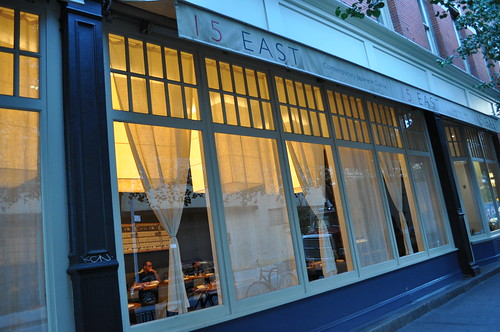
Restaurant owners Marco Moreira and Jo-Ann Makovitzky came up with the concept of 15 East as a restaurant that "serves contemporary Japanese cuisine and traditional sushi in an elegant and comfortable setting." With a long history of experience and interest in Japanese cuisine from Sao Paulo, Brazil to New York City, Mr. Moreira's main focus for 15 East is "seasonality, unusual ingredients, and unique flavor and textural combinations."
I've recently started getting into trying Japanese restaurants in the city that specialize in its sashimi/sushi offerings (e.g., Sushi Yasuda, Tomoe Sushi, etc.). Having grown up in a small town in Jersey, the local Japanese restaurants were mostly acceptable (some became my regular stops during my cravings for Japanese food), others were never frequented again after a visit or two. For that reason, the variety of fish offered at sushi bars was very limited. Though, one of the few exceptions I've come across in Jersey that offers very authentic Japanese cuisine and has a vast variety of fish flown in from Japan weekly is Jo-Sho, a modest little Japanese restaurant located in Somerset, owned by a Japanese couple--the husband is the sushi chef, the wife the general manager. What my mom likes to say is if you see Japanese families eating at a Japanese restaurant, that's when you know there will be excellent Japanese food--which is the case with Jo-Sho. It wouldn't be out of the ordinary to hear and witness many exchanges of conversation in Japanese between patrons and the owners.
With the issue of limited selection in mind, ordering omakase (chef's choice menu) seems very farfetched when the menus were so limited to begin with, so it had never really occurred to me to ever order that way. I played around with the idea of omakase when I read Frank Bruni's restaurant review of his revisit to Sushi Yasuda. I experienced my first omakase meal during my visit to Sushi Yasuda last December with my best friend, Lisa. I knew from then on out that in order to experience the smorgasbord of raw fish offered in the higher end sushi bars of New York City, omakase would always be the way to go.
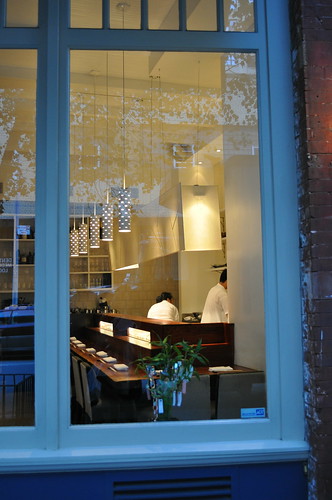
I called a month or so in advance for a reservation at the 15 East sushi bar (reservations are only available for the dining room at OpenTable.com) with seemingly no issues, except when I called back, the original mâitre d' made my reservation for the dining room. I would advise re-confirming a few days after you make the reservation to ensure that you'll be sitting at the sushi bar on your reservation date.

I read in many reviews of 15 East that sitting at the sushi bar with Chef Masato Shimizu, the executive sushi chef, was a MUST. I'm glad we decided to sit there. He was very knowledgeable and happy to answer any questions we had about the things we ordered that night. Also, being able to watch him prepare everything right before you was quite an experience (as you will see below). Before coming to New York, he apprenticed under Rikio Kugo, sushi master of Tokyo's Sukeroku. Once arriving to New York, he worked at Jewel Bako for 4 years before becoming executive sushi chef at 15 East.
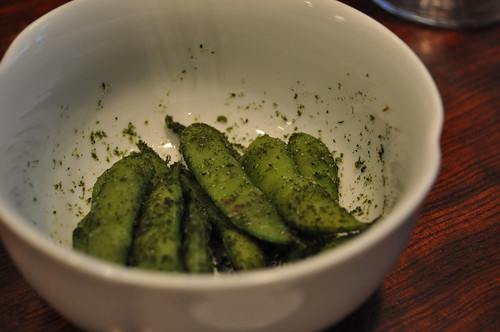
The restaurant started us off with seasoned heirloom edamame. The seasoning was very different than the typical sea salt sprinkled on top, making for a nice unexpected surprise upfront.

The amuse bouche of which we don't recall the contents/ingredients. I just remember it was soup-y, refreshing, and clean in flavor. When I asked Marcus about it, here was our conversation (pretty amusing if you ask me, haha):
Stefie: Do you remember what the amuse bouche was?Oh well. Guess that goes unsolved in the vault of forgotten bites and meals.
Marcus: What the heck is that?
Stefie: You know, the thing they gave us after the edamame, before the octopus?
Marcus: Oh. What the heck was that thing? I can't remember.
Stefie: Haha, yea me neither. Any ideas?
Marcus: I don't even remember eating that. It must have been like, an afterthought bite.
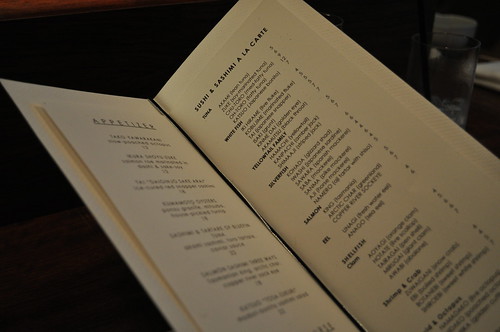
The sushi bar menu at 15 East. We opted to start with an appetizer (seen below) and the sushi omakase (i.e., the chef's choice of 10 pieces of sushi) for each of us. Omakase is Japanese for "entrust" where the meaning kindly extends to "entrusting" the sushi chef to prepare whatever he/she would like to make for you at a set price, where he/she is expected to serve you the best and highest quality items on the sushi bar menu. I would say that omakase is the Western equivalent of a tasting menu--meals/dishes that are predetermined by the chef--except the Japanese phrasing makes it more seemingly poetic.
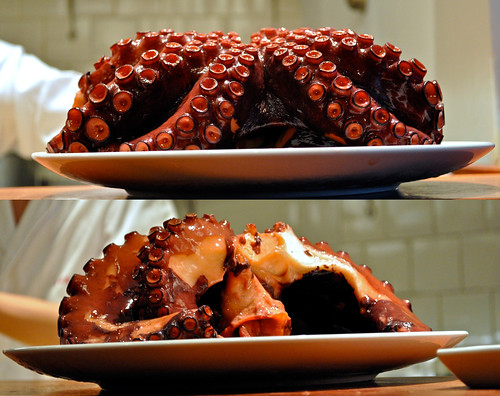
After reading several diners'/eaters' reviews, I gathered that Marcus and I HAD to order this appetizer at : the tako yamarakani, a slow-poached octopus. Chef Masa Shimizu showed us the entire tako from 15 East from which he slices off a few pieces from a tentacle to serve as an appetizer dish. This is the view from the front (top photograph) and the back (bottom). The sushi chef keeps the poached octopus in a pot of luke warm water behind the sushi bar.
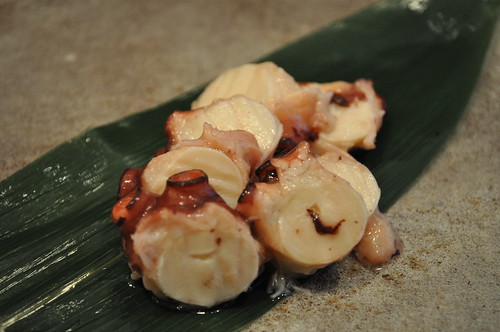
The tako yawarakani is plated on a thin square tile and served with some sea salt on the side for light coating. Usually, after having seen a mollusk like that, suction cups and all (is that even the correct term for those?), I would usually be a little reluctant to have eaten it right after. But in the spirit of everything (Marcus's birthday and being adventurous by ordering sushi omakase), my qualms somehow melted away, if they ever existed. With my chopsticks in hand, I tasted a piece of the tako with some sea salt. Oh, was it awesome! Perfectly moist and tender, light sea saltiness, not overcooked one bit. We barely needed to chew--it pretty much melted in our mouths. The slow-poaching preparation of the tako creates this amazing texture and flavor I have a hard time describing. Unlike typical cuttlefish/squid/octopus you may have had before, there was no chewiness to this octopus--it was smooth with a some structure. Before I could realize it, after some nearly orgasm-inducing bites, I went back for another piece, and it was all gone! So beware, this tako appetizer is addiction forming. I can almost guarantee once you've had this dish, you'll become a tako yawarakani enthusiast in no time!

This is Chef Masato's (everyone calls him Masa) work area--the sushi bar!
Each piece of sushi prepared by Chef Masato rests on a small mound of rice (called nigirizushi, Japanese for "hand-formed sushi") with a tiny bit of wasabi and soy sauce lightly brushed on the piece of raw fish. I usually try to avoid wasabi at all costs (somehow, most, if not all, mustards manage to ruin so many meals for me), but if it's prepared at a sushi bar, I don't seem to mind it. Maybe I'm a little elitist when it comes to sushi, so much that I prefer someone seasoning it with wasabi for me, haha.
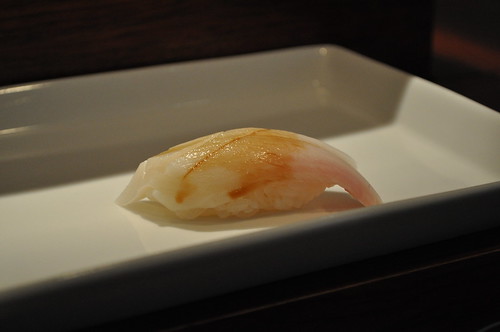
Hamachi no hara, yellowtail belly, was the first sushi in our sushi omakase. Very smooth, which made for a good start to our sushi tasting that night.
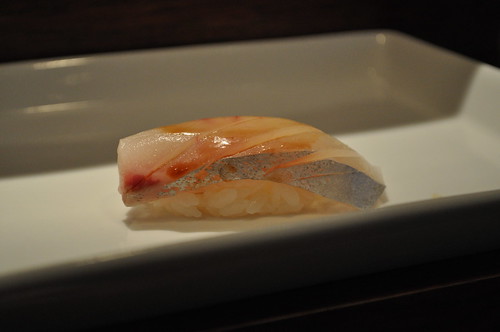
The next piece was shimaaji, striped jackfish, which we found to be very structured in texture--not as smooth as the others we had this same night, but still good.

The chef chose nodoguro, black-throat sea perch, as his third choice. Chef Masato told us that sea perch is very expensive in Japan (not so expensive here in the States) and that it is a very seasonal fish. Marcus and I were so preoccupied with trying to figure out what the chef said the fish was, that it kinda slipped our minds what this tasted like. We don't recall it tasting horrible, so Marcus said that this was pretty good.
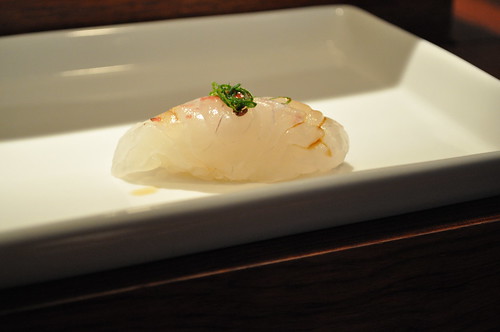
As our fourth piece of sushi, we were served the tai, Japanese red snapper, with pickled plum and scallions. Marcus found this to be soft like the chu-toro (see below), where the flavor was more full-bodied and sharper in taste.

I found this piece to have the most dimension and interesting preparation of all the sushi pieces we had. This is the kinme dai, golden eye snapper (kinme is Japanese for "gold eye", dai for "snapper" as seen above), with salt and lemon. The chef used a kitchen blow torch to toast the fish skin flavor, on the spot (see top part of photo)! The kinme dai had a really nice toasted flavor (and a tiny crunch) that paired well with the raw part of the fish. The salt and lemon accentuated this piece, too. Definitely one of my favorites of the night.
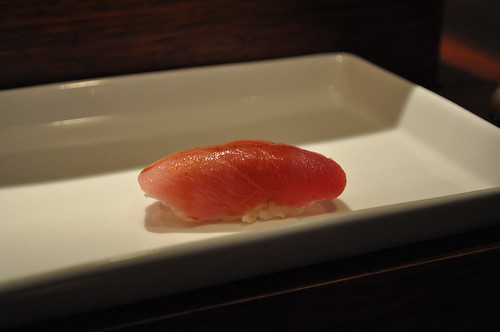
As one of my favorite items offered at the sushi bar, chu-toro (medium fatty tuna) is very rich in flavor and luscious in texture. This was Marcus's overall favorite of the night (one of my favorites of the night as well). The chu-toro just melted in our mouths (as the tako did). You can never go wrong with a quality piece of fatty tuna.

A nice follower to the chu-toro was oh-toro (i.e., tuna belly). It was very similar to the chu-toro, but slightly grainier and stringier. Not a favorite, but still savory.
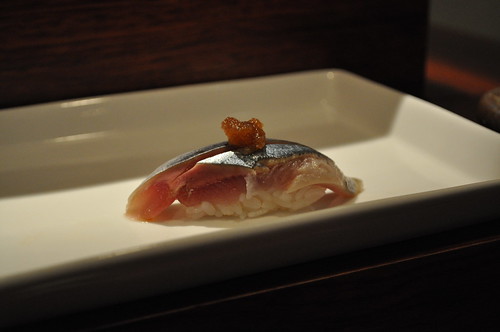
Next, the chef prepared sanma, pike mackerel, which he noted is a very seasonal offering at sushi bars. Marcus said this reminds him of albacore. I expected this to be a lot fishier tasting (which doesn't really bother me much) than it actually was (not fishy at all!) because of the iridescent/metallic skin. It had a smooth saltiness to it that I found to be great.
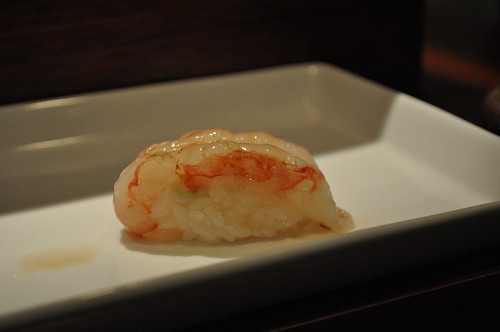
I was so glad we were able to have sweet shrimp during this visit, only because I wasn't sure when their prime season is usually over. This is the larger version of the standard sweet shrimp (amaebi) called botanebi. Subtly sweet and savory in flavor. I typically try to order this from a sushi menu if it's fresh and in season. Definitely a consistent favorite of mine.

The last piece served in our sushi omakase, this was the hotate--sea scallop seasoned with salt and yuzu zest, adding fresh, clean flavor (a nice plus!). Yuzu is an Asian citrus fruit that is very aromatic and has a similar tart flavor as that of grapefruit. The texture of the hotate was very different from the others, making it a nice piece to conclude our omakase and begin selecting a few more pieces of sushi we wanted to try or to repeat.
Marcus and I decided to repeat the chu-toro because we enjoyed it so much (not pictured twice, see photograph in original description above). I also wanted Marcus to try uni (sea urchin) as he'd never had it before, so Chef Masato recommended a tasting of uni from three different areas/regions.

The first uni (as well as Marcus's first!) was one from Hokkaido, Japan's most northern island. As I've read in an article from The New York Times, this region in Japan "commands the greatest prices" for sea urchins as it is the main uni-producing region. The texture was soft with a sea saltiness that didn't overpower the flavor from the uni, which was very rich in taste and creamy in texture. Definitely our favorite from the uni flight.

This second uni is from Kyuushu, Japan's most southwestern island, contrasting from previous from the northern island of Hokkaido. We found this uni to be less sea salty, smoother, and less grainy. The butteriness of the first uni definitely overshadows the texture of this piece.

The last uni is from Maine. Neither Marcus nor I were really feeling this one. It was really, really grainy and liquidy (if that's even a word). It is interesting, however, that the previous article I mentioned earlier from The New York Times discusses how "more than 95 percent of all the sea urchins harvested in Maine are sent to Japan" because the uni from Maine "is almost identical to Japan's highly prized Hokkaido sea urchins, and some seafood industry experts have speculated that the Maine sea urchins are being passed off as the far more valuable Japanese variety once they arrive there." Maybe the article is outdated as it was published back in 1990, 10 years ago, but it still surprises me that the uni from Maine tasted the way it did after having been described as almost on par with, if not better than, the precious Hokkaido uni.
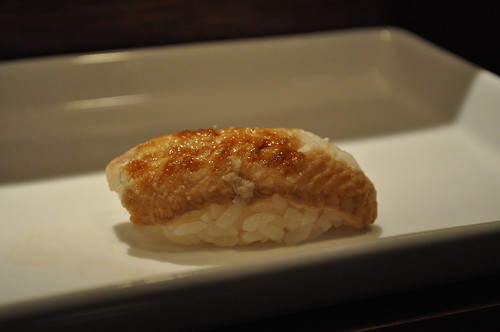
The last piece of the night (which happened to be on the house) was anago, sea eel, which the gentleman sitting at the next seat over from us at the sushi bar said was "Masa's specialty." The anago was totally boneless (a major plus) and the amount of glaze/sauce used was perfect--not overdone at all. Unagi glaze/sauce is typically prepared from a reduction of eel bone broth, soy sauce, rice wine and sugar and continuously flavored by dipping grilled eel into the sauce (also part of the grilled eel preparation process). No fishiness, not overcooked, and not overly marinated--I would recommend ordering anago from 15 East for sure!
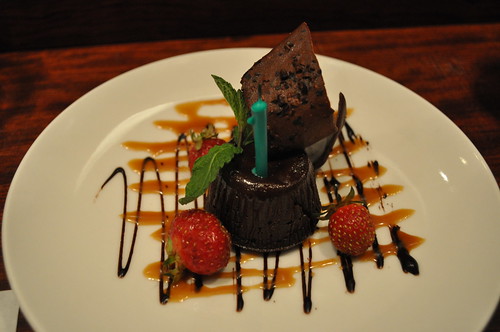
15 East gave Marcus a really nice birthday dessert (candle and all)--it was a flourless bittersweet chocolate cake with baby strawberries and biscotti, drizzled with chocolate and caramel sauce. Yay for deliciousness! Happy birthday to Marcus :D!

Marcus ordered a trio of ice creams/sorbet (from left to right): sake ice cream, blood orange sorbet, and green tea ice cream. The sake flavor ice cream was had a very strong sake flavor (surprise, surprise)--it reminded me of a more pungent version of the ice cream we had in the dessert we had at wd~50. The blood orange was refreshing and tart. Green tea ice cream has always been a favorite dessert of mine at Japanese restaurants, and the one offered at 15 East was no exception. It was very authentic in flavor--bold, bittersweet, and creamy. So good!

This dessert was a little disappointing. I had the frozen apricot soufflé with pistachio cream and walnuts. I was expecting an actual soufflé (I admit I may have failed to read the "frozen" part), and what I got was a crumbly, cold dessert, swimming in green cream. There wasn't much flavor or dimension to the soufflé part. Though, I have to say, the walnuts were the best part of the dessert--slightly caramelized, lightly toasted, and crunchy.
Findings: I would say that the sushi omakase at 15 East rivals the one I had at Sushi Yasuda last year, but the tako appetizer won me over in the end. Chef Masato was very amiable and knowledgeable, which is important to be an entertaining and well-rounded sushi chef. As I've already said, I highly recommend getting reservations at the sushi bar--it's an experience in itself. As for what to order--you won't go wrong with the 10-piece sushi omakase that we ordered--the chef will select for you what the most in-season and high quality pieces he feels you should try! And remember to be adventurous when you go--especially if you're up for getting the tako yamarakani. I would say it's a "must-have"--along with the kinme dai (gold eye snapper), chu-toro (medium fatty tuna), anago (sea eel) and the uni from Hokkaido. That'll give you the best sampler, if you're going to do kitchen/dining room items. But if mollusks and raw fish aren't your thing, you should still give it a whirl--it may change your mind!
A very happy birthday to Marcus, again (two weeks later) :D! Hope you had as much of a lovely (and delicious) time as I had. Love you!
Price point: $12 for appetizer; $55 per person for 10-piece sushi omakase; $7-12 each for additional piece of sushi; $8-9 for dessert.
--October 2, 2010
15 East
15 East 15th Street
New York, NY 10003
http://www.15eastrestaurant.com/index_.html

No comments:
Post a Comment